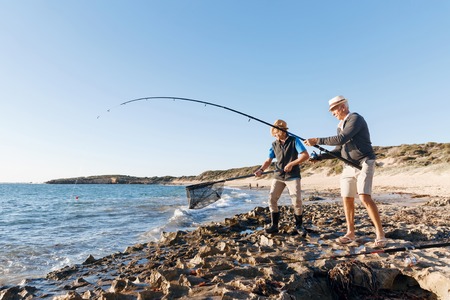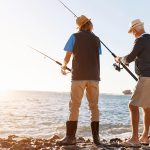1. Historical Background of Catch and Release in the U.S.
Catch and release fishing, a practice where anglers unhook and return fish to the water instead of keeping them, has deep roots in American sportfishing. While it might seem like a modern idea tied to environmentalism, it actually started gaining traction in the mid-20th century as part of a growing movement toward conservation.
The Early Days of Sportfishing
In the early 1900s, fishing in the United States was largely seen as a way to put food on the table. Anglers often kept everything they caught, and there were few regulations to limit harvests. As recreational fishing became more popular, concerns began to grow about overfishing and declining fish populations.
Conservationists Lead the Way
By the 1950s and 60s, conservation-minded anglers started promoting catch and release as a way to protect fish stocks for future generations. These early advocates weren’t just hobbyists—they included scientists, writers, and passionate outdoorsmen who understood the importance of sustainability.
Trout Unlimited: A Turning Point
One of the most influential organizations in promoting catch and release ethics was Trout Unlimited (TU), founded in 1959 in Michigan. TU’s mission focused on protecting coldwater fisheries, especially wild trout habitats. The group quickly became a leader in advocating for sustainable fishing practices.
| Year | Event | Impact on Catch and Release |
|---|---|---|
| 1959 | Founding of Trout Unlimited | Brought national attention to conservation-based angling |
| 1960s–70s | Rise of recreational fly fishing | Promoted ethical fishing practices like releasing wild trout |
| 1980s | State agencies adopt catch and release regulations | Helped rebuild fish populations in pressured waters |
The Cultural Shift Among Anglers
Catching a big fish used to mean taking it home and showing it off. But as more anglers embraced conservation values, attitudes began to shift. Releasing a trophy catch became just as rewarding—if not more so—than keeping it. This cultural change helped spread catch and release practices beyond fly fishing circles into bass fishing, saltwater angling, and more.
The Role of Education and Media
Fishing magazines, TV shows, and guidebooks started including information on proper catch and release techniques. This education effort played a big role in making sure released fish survived—and that anglers felt good about doing their part for conservation.
As catch and release grew from a niche idea into a mainstream ethic among American anglers, it laid the foundation for many of today’s sustainable fishing practices.
2. Cultural Shifts in Angler Ethics
Over the past several decades, the attitudes of American anglers have undergone significant changes, especially when it comes to how they view wildlife, conservation, and responsible fishing. These cultural shifts have played a huge role in shaping modern catch and release practices. Today’s anglers are more aware than ever of their impact on fish populations and aquatic ecosystems.
Changing Views on Wildlife
In earlier generations, fish were often seen primarily as a resource—something to catch, keep, and eat. But as public awareness about animal welfare has grown, many people now view fish as living creatures that deserve respect. This shift has helped promote ethical practices like handling fish gently and releasing them quickly to reduce stress or injury.
The Rise of Conservation Awareness
Environmental movements starting in the 1960s and 1970s brought a new spotlight on conservation. As pollution and habitat loss became national concerns, anglers began to realize their role in protecting natural resources. Organizations like Trout Unlimited and state-level conservation agencies started pushing for sustainable fishing practices, including catch and release.
Key Conservation Events That Influenced Anglers
| Year | Event | Impact on Angler Ethics |
|---|---|---|
| 1972 | Cleans Water Act Passed | Brought attention to water quality and fish habitats |
| 1980s | Trout Unlimited Expands Programs | Pushed for fly-fishing ethics and stream protection |
| 1990s | No-Kill Fishing Becomes Popular | Mainstreamed catch and release as an ethical choice |
| 2000s–Present | YouTube & Social Media Influence | Anglers showcase responsible behavior publicly, influencing others |
Evolving Outdoor Recreation Trends
The way Americans spend time outdoors has also changed. More people are looking for experiences rather than trophies. For many anglers today, it’s less about taking home a cooler full of fish and more about enjoying nature, the thrill of the catch, and sharing the moment online or with friends. As outdoor recreation becomes more experience-driven, ethical fishing aligns well with this mindset.
A New Generation of Ethical Anglers
Younger anglers are growing up with messages about sustainability from day one. They’re learning through school programs, YouTube channels, and apps that teach proper catch and release techniques. Gear companies are also promoting eco-friendly tools like barbless hooks and rubber nets. All these factors support a culture where ethical fishing is not only encouraged but expected.
This ongoing cultural evolution continues to shape how American sportfishing looks today—from what gear anglers choose to how they talk about their catches—and its laying the foundation for more responsible fishing practices in the future.

3. Scientific Insights and Their Role in Shaping Best Practices
Over the past few decades, catch and release fishing has become more than just a feel-good practice—it’s now guided by solid science. As researchers have studied fish behavior, physiology, and survival rates, their discoveries have helped shape the way American anglers approach sportfishing with conservation in mind.
The Science Behind Catch and Release
Fish are living creatures that can experience stress and injury when caught. Scientists have learned a lot about what helps fish survive after being released. These findings have led to recommendations that make catch and release not only ethical but effective in helping fish populations stay healthy.
Key Scientific Findings That Influence Best Practices
| Scientific Insight | Recommended Practice |
|---|---|
| Fish experience less stress when handled briefly | Minimize handling time—get the fish back in the water quickly |
| Dry hands or rough surfaces damage fish slime coat | Wet your hands before touching the fish; avoid dry towels or rough gloves |
| Hooks can cause serious injury if deeply embedded | Use barbless hooks to reduce damage and ease hook removal |
| Lifting fish vertically can injure internal organs | Support the fish horizontally with both hands during photos or handling |
| Fish fight longer on light gear, increasing exhaustion | Use appropriate tackle to land fish quickly and reduce fatigue |
The Move Toward Barbless Hooks
One of the biggest changes inspired by research is the growing use of barbless hooks. Studies show that barbless hooks reduce injury and make it easier to release fish safely. While some anglers worry about losing more fish, many find that proper technique keeps hook-up rates high even without barbs.
Tackling Time Out of Water
A major focus of recent studies is how long a fish stays out of water. Researchers found that keeping a fish out for more than 30 seconds significantly lowers its chances of survival. This has led to public campaigns like “Keep ‘Em Wet,” which encourage anglers to plan their photo or release before lifting the fish from the water.
The Ongoing Role of Science in Sportfishing Ethics
The relationship between science and sportfishing continues to grow. Fisheries biologists regularly update guidelines as new data emerges. Anglers who stay informed and adjust their techniques are not only improving their own fishing experiences—theyre also playing a critical role in protecting aquatic ecosystems for future generations.
4. Media, Education, and Community Influence
Over the past few decades, media and community-driven efforts have played a major role in shaping the ethics of catch and release within American sportfishing culture. As more anglers become aware of conservation issues, various platforms—from television to social media—have stepped up to promote responsible fishing practices in ways that are both engaging and educational.
Fishing Shows and Outdoor Media
Television shows and outdoor magazines have long been influential in American angling. Popular programs like “Bill Dance Outdoors” or “Bassmaster” not only entertain but also educate viewers on proper handling techniques, gear choices that reduce harm, and the importance of releasing fish safely. These shows often feature professional anglers demonstrating best practices, making it easy for viewers to adopt these methods in their own fishing routines.
Youth Programs and Educational Outreach
Organizations such as Trout Unlimited, Take Me Fishing, and local fish and wildlife agencies run youth-focused programs that teach young anglers about aquatic ecosystems and ethical fishing behavior. By introducing catch and release principles early on, these programs help build a foundation for lifelong stewardship of natural resources.
Examples of Youth Programs Promoting Catch and Release
| Program Name | Organization | Focus Area |
|---|---|---|
| Trout in the Classroom | Trout Unlimited | Aquatic education & trout conservation |
| Hooked on Fishing – Not on Drugs | U.S. Fish & Wildlife Service | Youth engagement & ethical angling |
| Lets Go Fishing Clinics | State DNRs (e.g., Minnesota DNR) | Hands-on fishing & conservation education |
The Power of Social Media Campaigns
Social media has become a powerful tool for spreading awareness about catch and release ethics. Influencers, YouTubers, and grassroots campaigns regularly post videos and infographics showing proper fish handling techniques or promoting the use of barbless hooks. Hashtags like #CatchAndRelease or #FishResponsibly help create a sense of community among ethical anglers while encouraging peer-to-peer learning.
Common Social Media Messages Promoting Ethical Angling
- “Keep ’em wet” – Encourages keeping fish in water during photos.
- #CatchPhotoRelease – Promotes quick photo-taking before release.
- #BarblessForTheWin – Highlights the use of barbless hooks to reduce injury.
Together, media outlets, educational programs, and online communities have fostered a growing movement toward responsible angling across the U.S. They continue to influence both new and experienced anglers by making catch and release not just a practice—but a shared value within American sportfishing culture.
5. Current Debates and Ethical Considerations
The catch and release practice, once considered the gold standard for conservation in American sportfishing, is now at the center of new ethical debates. As more anglers and scientists weigh in, questions about fish sentience, stress, and post-release survival are challenging old assumptions.
Fish Sentience: Can Fish Feel Pain?
One of the most talked-about topics is whether fish can feel pain. Studies have shown that fish have nervous systems capable of responding to injury, which some interpret as evidence of sentience. This has sparked concern among anglers who want to ensure their actions do not cause unnecessary suffering. However, others argue that while fish may react to stimuli, it doesnt necessarily mean they experience pain in the same way humans or mammals do.
Does Catch and Release Really Work?
Another major debate is about the effectiveness of catch and release in conserving fish populations. While the idea is to let the fish go so it can survive and reproduce, research shows that not all released fish make it. Factors like hook placement, handling time, water temperature, and species type all influence survival rates.
Estimated Mortality Rates After Release
| Species | Average Mortality Rate | Key Factors Affecting Survival |
|---|---|---|
| Trout | 10-30% | Water temperature, hook type |
| Bass | 5-15% | Handling time, air exposure |
| Salmon | 20-40% | Exhaustion during fight, water conditions |
The Role of Angler Responsibility
Many anglers are now asking themselves: Is it enough to simply release the fish? Ethical catch and release involves more than just letting go—it includes minimizing harm by using barbless hooks, wetting hands before handling fish, reducing air exposure, and avoiding fishing during extreme weather or spawning seasons.
A Shift in Perspective
This ongoing discussion is creating a shift in how people view sportfishing. Some anglers are adopting more selective practices—choosing when and where to fish based on environmental conditions or even deciding to keep fewer fish rather than releasing them all. Others are calling for clearer guidelines from wildlife agencies to support ethical angling practices nationwide.
Common Angler Perspectives on Catch and Release Ethics
| Perspective | Main Argument |
|---|---|
| Conservationist Anglers | C&R helps maintain healthy populations if done responsibly. |
| Animal Welfare Advocates | C&R causes unnecessary stress and should be limited. |
| Traditionalists | C&R is part of modern fishing ethics but should be balanced with harvesting. |
The evolution of catch and release ethics continues as science advances and cultural values shift. Understanding these current debates helps anglers make more informed choices on the water.


